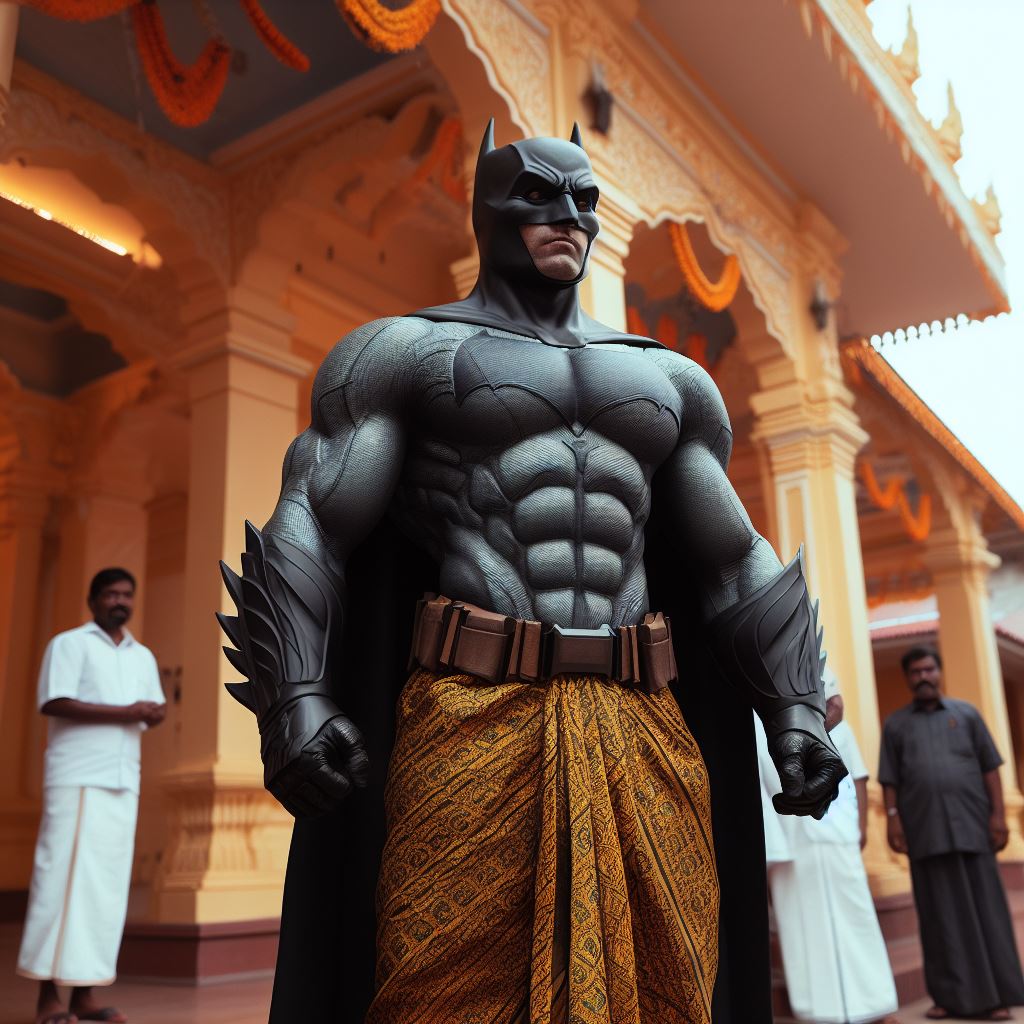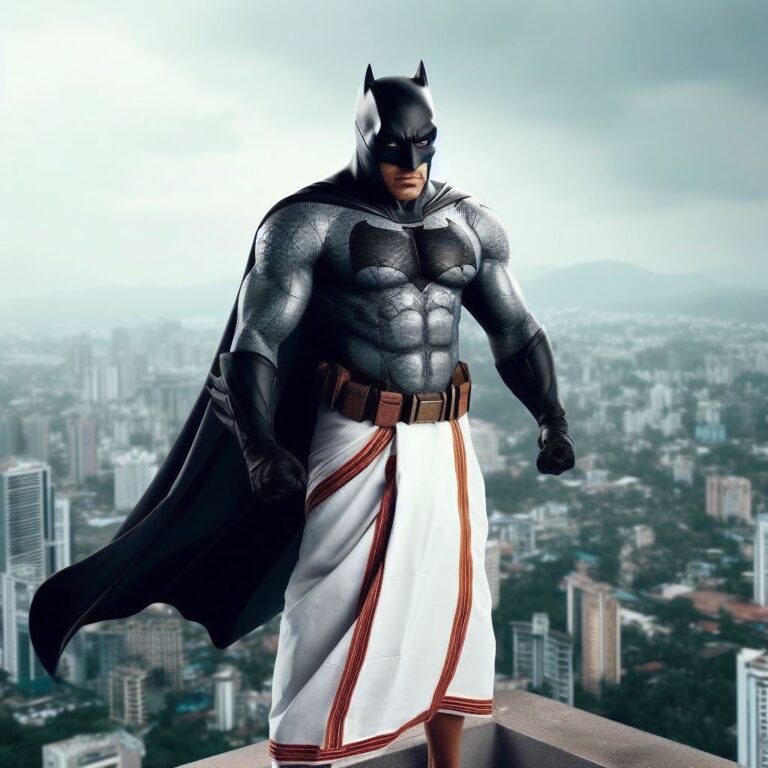The lungi and veshti emerge as pragmatic choices of clothing in response to the hot and humid climate prevalent in South India.
With the region experiencing elevated temperatures for a significant duration of the year, both lungis and veshtis, designed to be loose and often crafted from breathable fabrics like cotton, offer optimal ventilation and airflow.
This unique design not only ensures comfort but also aids in temperature regulation, making lungis and veshtis popular choices for individuals navigating the challenging weather conditions, particularly within the confines of their homes or in casual settings.
Table of Contents

The appeal of these garments lies in their shared capacity to provide unhindered freedom of movement, addressing the active lifestyles commonly found in the region.
Beyond their functional attributes, the lungi and veshti transcend their utilitarian roles, becoming symbols of cultural heritage in the vibrant tapestry of South Indian traditions.
These traditional pieces of clothing seamlessly connect the past with the present, offering tangible links to the region’s rich history while serving as practical solutions to cope with the demanding climatic conditions.

Celebrated for their practicality, comfort, and cultural significance, the lungi and veshti take center stage in this exploration of South Indian attire.
This article delves into the multifaceted allure of these traditional garments, shedding light on their inherent benefits, cultural importance, and the nuanced art of donning them.
By examining the enduring charm of the lungi and veshti, this piece aims to underscore why they remain cherished and enduring choices within the cultural fabric of South India.
Benefits of Wearing Lungi or Vesti ( aka mundu / dhoti )
Comfort and Ease of Movement
Crafted from lightweight, breathable fabrics like cotton, lungis offer unparalleled comfort, especially in the blistering heat of South Indian summers.
The loose-fitting design ensures unrestricted movement, catering to the active lifestyles prevalent in the region.
On the other hand, the Vesti, with its more structured and formal design, provides a sense of grace and sophistication, making it an excellent choice for formal occasions.

Affordability and Accessibility
One of the lungi’s remarkable traits is its affordability.
In a world where fashion trends often come with hefty price tags, lungis remain accessible to individuals from diverse socio-economic backgrounds, making them a practical choice for everyday casual wear.
Vesti, while possibly more expensive, is seen as an investment in formal attire, adding a touch of elegance to special events and cultural ceremonies.

Cultural Significance and Identity
Beyond their practicality, lungis and vestis hold profound cultural significance in South India.
Lungis symbolize a connection to heritage and traditions, embodying a way of life passed down through generations. They are a staple in casual settings and at home.
In contrast, the Vesti, being more formal, becomes a symbol of cultural identity during ceremonies, weddings, and other important events, reinforcing a sense of pride and tradition.
Versatility in Everyday Wear
Lungis are incredibly versatile, finding a place in various aspects of daily life. They are ideal as casual wear at home, providing relaxation and ease.
Additionally, lungis double up as comfortable sleepwear, ensuring a restful night even during warm weather.
Vesti, with its formal appeal, becomes a go-to choice for occasions where a more dignified look is desired, showcasing the wearer’s respect for the event and cultural norms.

Quick Drying and Adaptability
The lightweight nature of lungis ensures quick drying after washing, a practical feature in regions experiencing frequent rainfall or high humidity.
This characteristic allows for hassle-free maintenance, adding to the lungi’s convenience and functionality for everyday wear.
Vesti, being more formal and often made of silk or other luxurious fabrics, requires a bit more care but is worth the effort for the elevated look it provides on special occasions.

How to Wear a Lungi or Vesti
To wear a lungi or vesti, follow these simple steps:
- Wrap Around Waist: Hold the lungi horizontally against your waist, with the top edge aligned with your waistline. For the Vesti, the wrapping process may be more intricate, involving multiple folds and drapes for a formal appearance.
- Pleat the Lungi or Vesti: Gather the fabric in front of you and create pleats, typically ranging from 4 to 8, depending on the width of the lungi or the formality of the occasion for the Vesti.
- Tuck the Pleats: Tuck the pleats into the waistband for the lungi, ensuring they are arranged neatly. This creates a kilt-like appearance in the front. For the Vesti, the pleats might be tucked in a more structured and stylized manner, adding to its formal aesthetic.
- Secure with a Knot or Pin: Once the pleats are tucked for the lungi, gather the remaining fabric at the back and bring it around your waist to the front. Tie the ends together in a knot or use a safety pin to secure them, preventing the lungi from coming undone. For the Vesti, the draping and securing process may involve more intricate folds and a neatly tucked end.
In conclusion, the lungi and vesti epitomize the harmonious blend of tradition, practicality, and formality in South Indian attire.
The lungi, with its casual charm, offers comfort and ease for everyday wear, while the Vesti, with its formal grace, becomes a symbol of cultural identity and elegance during special occasions.
Embracing both these traditional garments allows individuals to navigate the diverse landscape of South Indian culture with style and authenticity.
FAQs about Lungi
- What is a lungi? A lungi is a traditional garment worn by men, originating from South Asia. It’s a wrapped skirt-like garment made from cotton or other fabrics.
- How is a lungi worn? To wear a lungi, wrap it around the waist and tuck in the loose end. It’s secured without a knot, allowing for comfort and easy movement.
- Where is the lungi commonly worn? Lungis are prevalent in South India, Bangladesh, Sri Lanka, and other Southeast Asian countries. They are popular daily wear for various activities.
- What are the advantages of wearing a lungi? Lungis are known for their comfort, breathability, and versatility. They are particularly suitable for warm climates and casual settings.
- Are lungis only for men? While traditionally worn by men, lungis are also adapted for women in some regions. Designs and patterns may vary based on cultural preferences.
- Can lungis be worn on formal occasions? Lungis are generally considered casual wear. However, in some cultural contexts, they might be acceptable for specific formal events or ceremonies.
- How do lungis differ from other traditional garments? Unlike dhotis or sarongs, lungis are typically shorter and simpler, making them a practical choice for daily activities and routines.
- Are lungis one-size-fits-all? Lungis come in various lengths and widths to accommodate different body sizes. Some may have adjustable features for a better fit.
- How do you wash and maintain a lungi? Most lungis are machine washable. It’s recommended to follow care instructions on the garment for specific washing and maintenance guidelines.
- Can lungis be a fashion statement? Absolutely! With diverse colors, patterns, and fabrics, lungis can be styled creatively. Many people incorporate them into their fashion choices to make a unique statement.


0 Comments